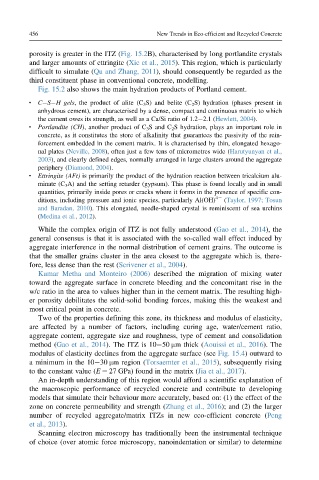Page 506 - New Trends in Eco efficient and Recycled Concrete
P. 506
456 New Trends in Eco-efficient and Recycled Concrete
porosity is greater in the ITZ (Fig. 15.2B), characterised by long portlandite crystals
and larger amounts of ettringite (Xie et al., 2015). This region, which is particularly
difficult to simulate (Qu and Zhang, 2011), should consequently be regarded as the
third constituent phase in conventional concrete, modelling.
Fig. 15.2 also shows the main hydration products of Portland cement.
C S H gels, the product of alite (C 3 S) and belite (C 2 S) hydration (phases present in
anhydrous cement), are characterised by a dense, compact and continuous matrix to which
the cement owes its strength, as well as a Ca/Si ratio of 1.2 2.1 (Hewlett, 2004).
Portlandite (CH), another product of C 3 S and C 2 S hydration, plays an important role in
concrete, as it constitutes the store of alkalinity that guarantees the passivity of the rein-
forcement embedded in the cement matrix. It is characterised by thin, elongated hexago-
nal plates (Neville, 2008), often just a few tens of micrometres wide (Harutyunyan et al.,
2003), and clearly defined edges, normally arranged in large clusters around the aggregate
periphery (Diamond, 2004).
Ettringite (AFt) is primarily the product of the hydration reaction between tricalcium alu-
minate (C 3 A) and the setting retarder (gypsum). This phase is found locally and in small
quantities, primarily inside pores or cracks where it forms in the presence of specific con-
42
ditions, including pressure and ionic species, particularly Al(OH) (Taylor, 1997; Tosun
and Baradan, 2010). This elongated, needle-shaped crystal is reminiscent of sea urchins
(Medina et al., 2012).
While the complex origin of ITZ is not fully understood (Gao et al., 2014), the
general consensus is that it is associated with the so-called wall effect induced by
aggregate interference in the normal distribution of cement grains. The outcome is
that the smaller grains cluster in the area closest to the aggregate which is, there-
fore, less dense than the rest (Scrivener et al., 2004).
Kumar Metha and Monteiro (2006) described the migration of mixing water
toward the aggregate surface in concrete bleeding and the concomitant rise in the
w/c ratio in the area to values higher than in the cement matrix. The resulting high-
er porosity debilitates the solid-solid bonding forces, making this the weakest and
most critical point in concrete.
Two of the properties defining this zone, its thickness and modulus of elasticity,
are affected by a number of factors, including curing age, water/cement ratio,
aggregate content, aggregate size and roughness, type of cement and consolidation
method (Gao et al., 2014). The ITZ is 10 50 μm thick (Aouissi et al., 2016). The
modulus of elasticity declines from the aggregate surface (see Fig. 15.4) outward to
a minimum in the 10 30 μm region (Torsaemter et al., 2015), subsequently rising
to the constant value (E 5 27 GPa) found in the matrix (Jia et al., 2017).
An in-depth understanding of this region would afford a scientific explanation of
the macroscopic performance of recycled concrete and contribute to developing
models that simulate their behaviour more accurately, based on: (1) the effect of the
zone on concrete permeability and strength (Zhang et al., 2016); and (2) the larger
number of recycled aggregate/matrix ITZs in new eco-efficient concrete (Peng
et al., 2013).
Scanning electron microscopy has traditionally been the instrumental technique
of choice (over atomic force microscopy, nanoindentation or similar) to determine

